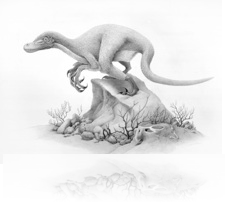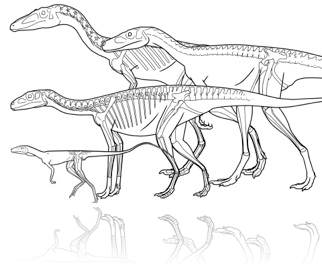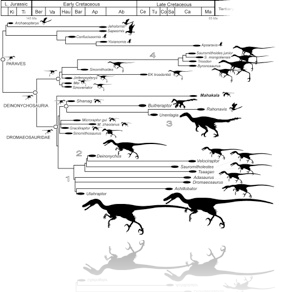 |  |
| |
 |
Deinonychosauria is the dinosaurian group that includes dromaeosaurids and troodontids. Dromaeosaurids and troodontids have a diverse evolutionary history spanning most of the Cretaceous Period from 135 millions ago until the K/T extinction 65 millions ago. These two groups are the closest relatives to birds and therefore of crucial importance for studies of bird origins. In particular I am interested in the sequence and pattern of acquisition of traits associated with flight. |
| |
Origin of Dinosaurs Dinosaurs originated in the Late Triassic Period some 230 to 200 million years ago. Their origins marked a replacement of faunas previously dominated by a variety of basal archosaur lineages such a aetosaurs and “rauisuchians”. Until recently the only evidence of dinosaur precursors was from the Middle Triassic Chañares Formation of Argentina. The recently discovered Hayden Quarry near Ghost Ranch New Mexico is providing a window into the early evolution of dinosaurs and their immediate precursors. Together with colleagues from the Field Museum, University of Utah, and University of Washington, we are interested in exploring the rise of this most intriguing group of reptiles. |  |
| |
 | Body Size Trends in Theropod Evolution Throughout their evolutionary history, theropod dinosaurs have exhibited a wide range of body sizes. From relatively small animals such as Coelophysis early in the clade’s history to the largest terrestrial carnivores like Tyrannosaurus rex to the smallest of humming birds, theropods have evolved to the extremes of body size. My current research focuses on characterizing the pattern of size change among theropods. Questions being addressed span the coelurosaur tree. Are there any directional trends in body size? Are coelurosaurs truly characterized by a size decrease? In particular I am interested in understanding the basis for these size trends and the role body size plays in major evolutionary event--e.g., miniaturization’s role in feather and flight evolution (see Turner et al., 2007). |

